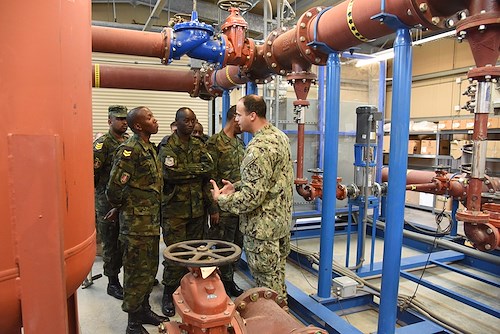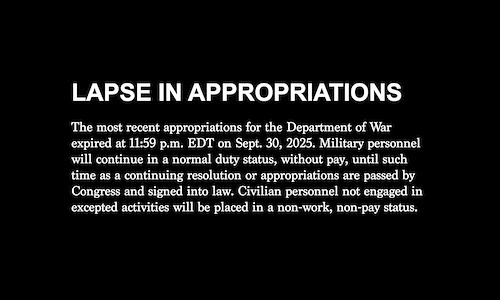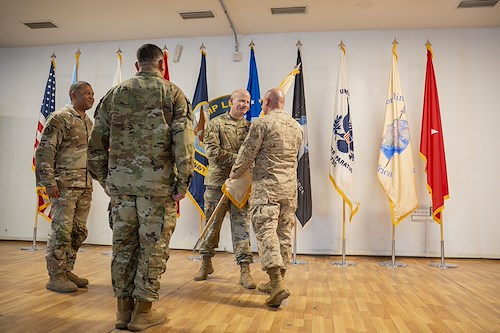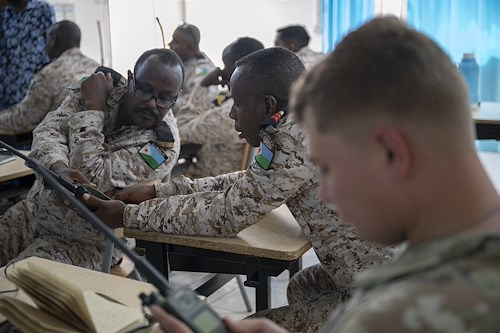Gallery contains 7 images
×
Photo 1 of 7
RDF engineers see camp concepts become reality
U.S. Navy Lt. Raul Cuevas, Camp Lemonnier Public Works Department civil engineer corps officer, explains the inner workings of the reverse osmosis water purification unit to Rwanda Defence Force engineers at Camp Lemonnier, Djibouti, Feb. 23, 2016. The ROWPU provides clean, drinkable water to the residents of Camp Lemonnier. (U.S. Air Force photo by Staff Sgt. Victoria Sneed)
Photo by: U.S. Air Force Staff Sgt. Victoria Sneed
Photo 2 of 7
RDF engineers see camp concepts become reality
U.S. Navy Lt. Raul Cuevas, Camp Lemonnier Public Works Department civil engineer corps officer, points out the different sections of the sewage treatment facility to Rwanda Defence Force engineers at Camp Lemonnier, Djibouti, Feb. 23, 2016. RDF members received a tour of essential utilities for an expeditionary camp so they could see the application of prior base planning lessons shared by Combined Joint Task Force-Horn of Africa engineers. (U.S. Air Force photo by Staff Sgt. Victoria Sneed)
Photo by: U.S. Air Force Staff Sgt. Victoria Sneed
Photo 3 of 7
RDF engineers see camp concepts become reality
U.S. Marine Cpl. Zachary Ernesti, Combined Joint Task Force-Horn of Africa armory NCO-in-charge, displays a rifle stored in the armory to Rwanda Defence Force Col. Faustin Kalisa, RDF Battalion commander, at Camp Lemonnier, Djibouti, Feb. 23, 2016. The RDF engineers toured Camp Lemonnier to see how U.S. expeditionary structures are set up. (U.S. Air Force photo by Staff Sgt. Victoria Sneed)
Photo by: U.S. Air Force Staff Sgt. Victoria Sneed
Photo 4 of 7
RDF engineers see camp concepts become reality
U.S. Air Force Master Sgt. Christopher Mason, 870th Air Expeditionary Squadron Civil Engineering power production, shows Rwanda Defence Force engineers a 12-person tent at Chebelley Airfield, Djibouti, Feb. 25, 2016. RDF members visited Chebelley and Camp Lemonnier to see how U.S. partners set up different types of expeditionary camps. (U.S. Air Force photo by Staff Sgt. Victoria Sneed)
Photo by: U.S. Air Force Staff Sgt. Victoria Sneed
Photo 5 of 7
RDF engineers see camp concepts become reality
U.S. Navy Equipment Operator 2nd Class Tom Ross, Naval Mobile Construction Battalion 22, explains trailer detachment to Rwanda Defence Force engineers during their tour of Camp Lemonnier, Djibouti, Feb. 24, 2016. RDF members learned more about U.S. expeditionary camps and what equipment is used to build and maintain them. (U.S. Air Force photo by Staff Sgt. Victoria Sneed)
Photo by: U.S. Air Force Staff Sgt. Victoria Sneed
Photo 6 of 7
RDF engineers see camp concepts become reality
Rwanda Defence Force engineers learn more about fuel storage bladders from Airmen assigned to Combined Joint Task Force-Horn of Africa at Chebelley Airfield, Djibouti, Feb. 25, 2016. In addition to receiving a tour of facilities and infrastructure for expeditionary camps, the U.S. and RDF engineers used the opportunity to further enhance the relationships they’ve built with each other over the past several months. (U.S. Air Force photo by Staff Sgt. Victoria Sneed)
Photo by: U.S. Air Force Staff Sgt. Victoria Sneed
Photo 7 of 7
RDF engineers see camp concepts become reality
Seabees assigned to Naval Mobile Construction Battalion 22 display concrete support to Rwanda Defence Force engineers during their tour of Camp Lemonnier, Djibouti, Feb. 24, 2016. RDF members viewed U.S. expeditionary construction capabilities to solidify practices shared in prior exchanges with Combined Joint Task Force-Horn of Africa engineers. (U.S. Air Force photo by Staff Sgt. Victoria Sneed)
Photo by: U.S. Air Force Staff Sgt. Victoria Sneed
After classroom discussion, whiteboard drawings and digital renderings, the next step to cementing a theory is seeing plans enacted in reality.
This is the direction engineers from Combined Joint Task Force-Horn of Africa and the Rwanda Defence Force have taken over the past three months to share best practices on expeditionary camp building.
“After theory we have a gap of how things are put into context,” said RDF Air Force Maj. Jean Paul Munana, RDF Engineering Battalion squadron commander. “We needed to see how that theory is converted into reality.”
Six RDF engineers visited Camp Lemonnier and Chebelley Airfield, Djibouti, Feb. 23-26, 2016, to see how U.S. military members work and live in different types of expeditionary camps.
RDF members toured critical utilities that support Camp Lemonnier’s more than 4,000 residents. Some of the facilities shown were the reverse osmosis water purification unit, power production plant, waste water treatment facility, trash incinerator, armory, ammo supply point, and construction supply and equipment yards. They also stayed in living quarters and ate at the dining facilities on Camp Lemonnier during their stay.
“We tried to show them things that are common to most base camps regardless of the size,” said U.S. Navy Lt. Steven Hunt, CJTF-HOA engineering future operations officer. “It’s hard to get the perspective of something just by talking about it or from a picture or video.”
The tours of both Camp Lemonnier and Chebelley Airfield provided the RDF a chance to see the differences in levels of expeditionary camp permanence.
“We talked about some things at the RDF Engineering Battalion in Kigali, but seeing things, the size of them and how they are laid out, is more beneficial,” said Hunt. “You get a much more in-depth look by walking through a facility, and you can ask questions of the person in charge.”
After seeing Camp Lemonnier, an established, enduring encampment, the RDF visited Chebelley Airfield to see its fuel storage bladders, 12-man tents, power distribution, and security features for comparison.
“It is good for us to see Chebelley because it was developed exactly from U.S. expeditionary doctrine,” said Munana. “Unlike Lemonnier that was designed from existing facilities.”
By seeing both expeditionary sites, RDF engineers learned more about what facilities are necessary for operations in austere conditions like those in Djibouti. The engagement also presents more opportunities to build lasting ties that will reinforce partnerships throughout the Horn of Africa.
“The better relationship we have with partners, the better we understand their constraints and abilities,” said Hunt. “It also allows us to be able to know how to provide assistance to help their missions succeed.”

























